英语:unit3 protecting ourselves-welcome课件(牛津译林版选修10)
文档属性
| 名称 | 英语:unit3 protecting ourselves-welcome课件(牛津译林版选修10) |

|
|
| 格式 | rar | ||
| 文件大小 | 970.8KB | ||
| 资源类型 | 教案 | ||
| 版本资源 | 牛津译林版 | ||
| 科目 | 英语 | ||
| 更新时间 | 2009-09-08 11:34:00 | ||
图片预览

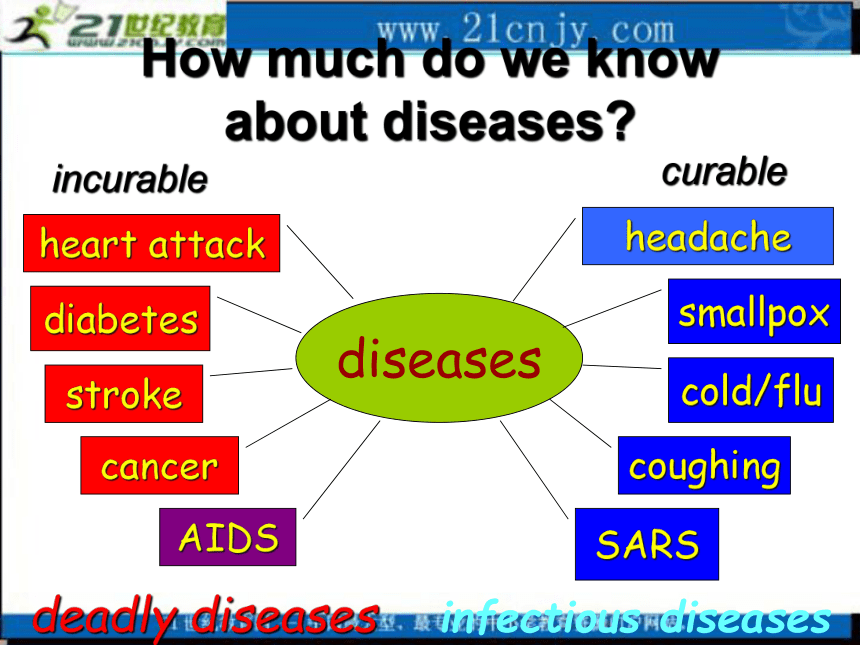
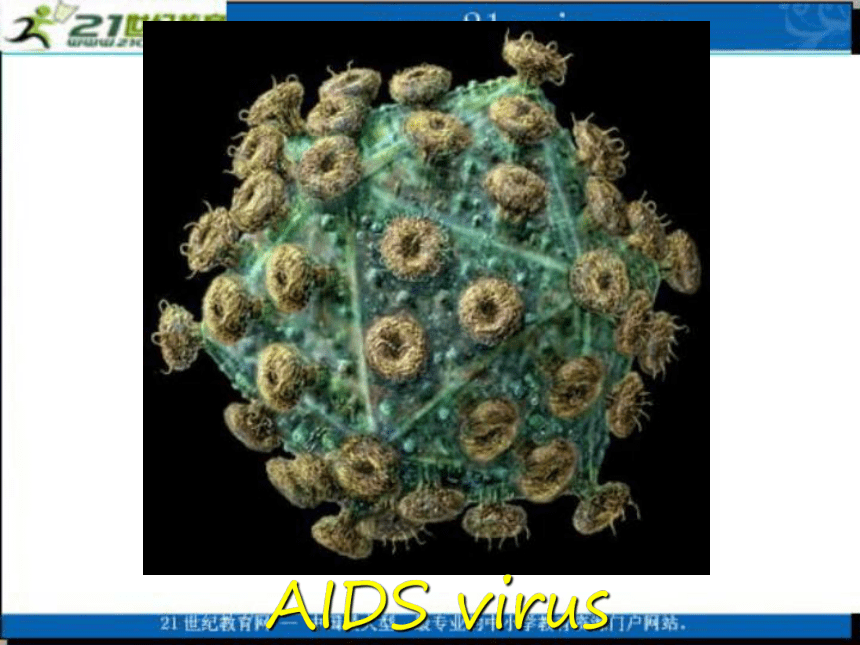
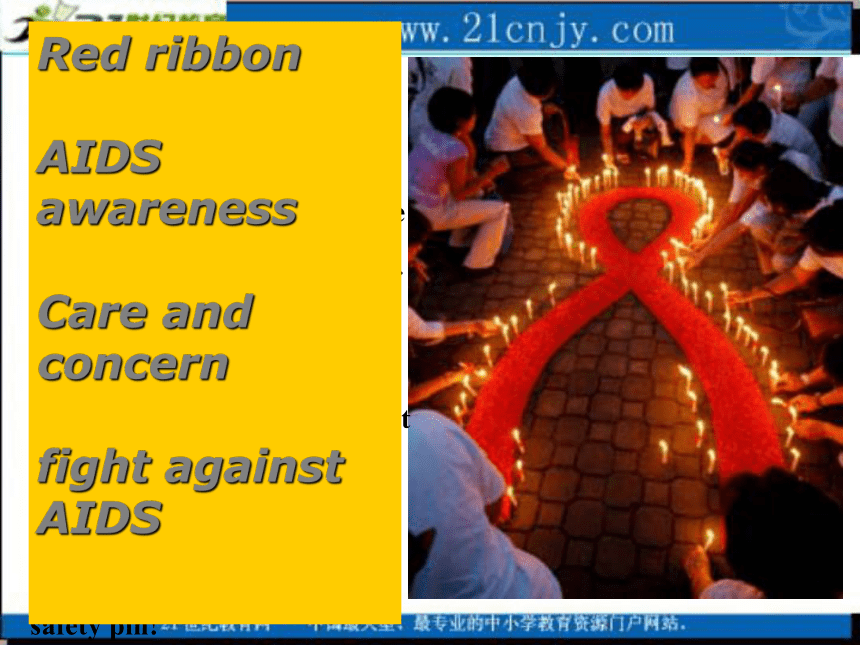
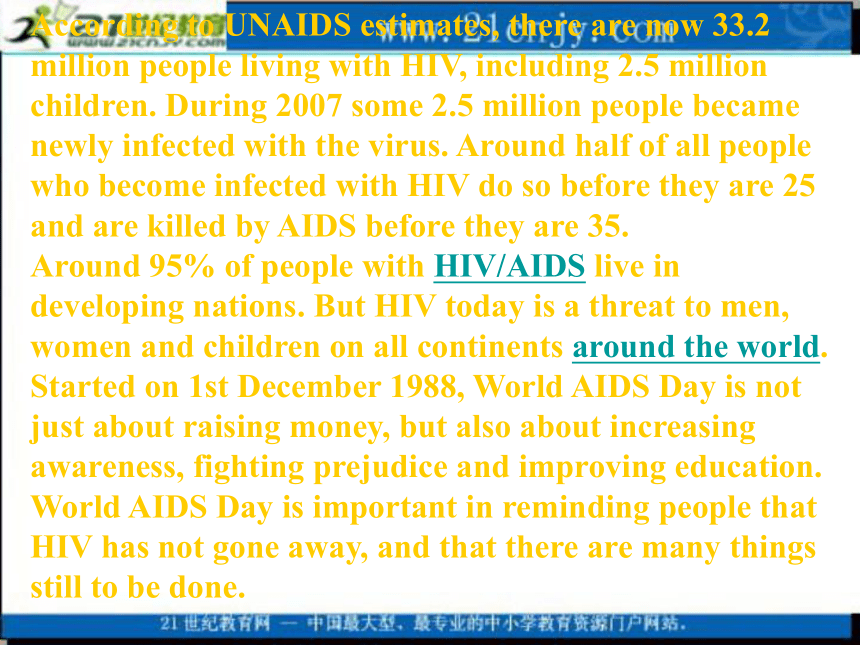
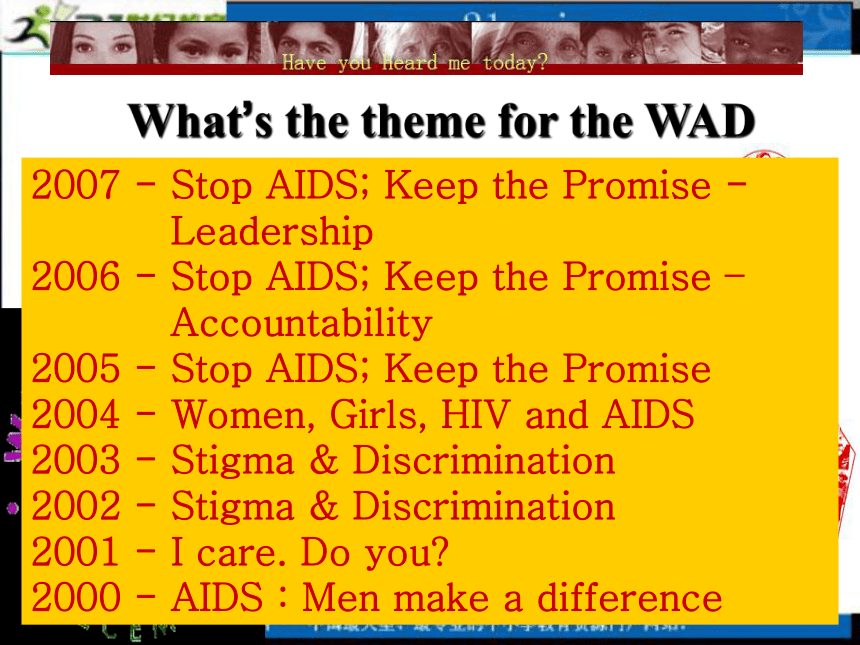
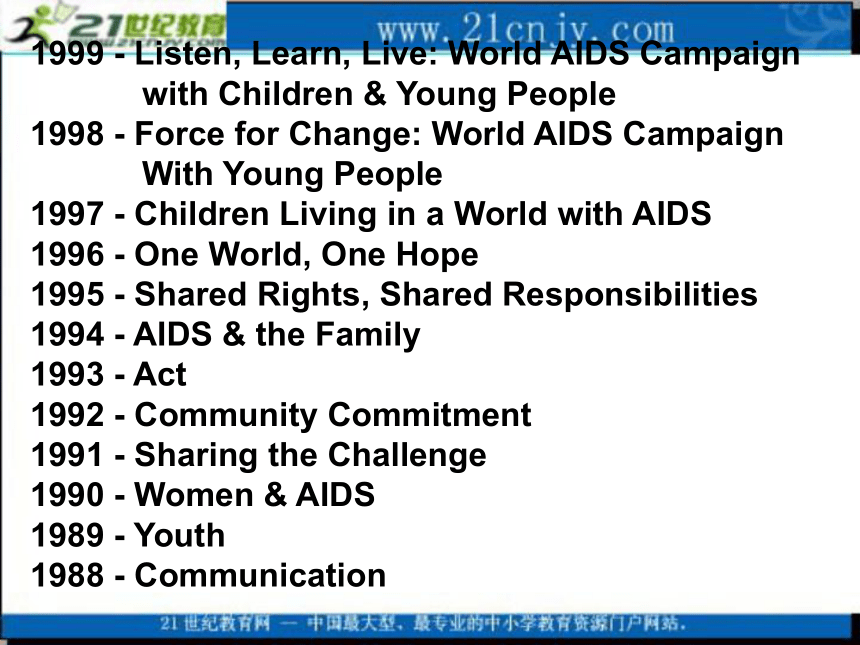
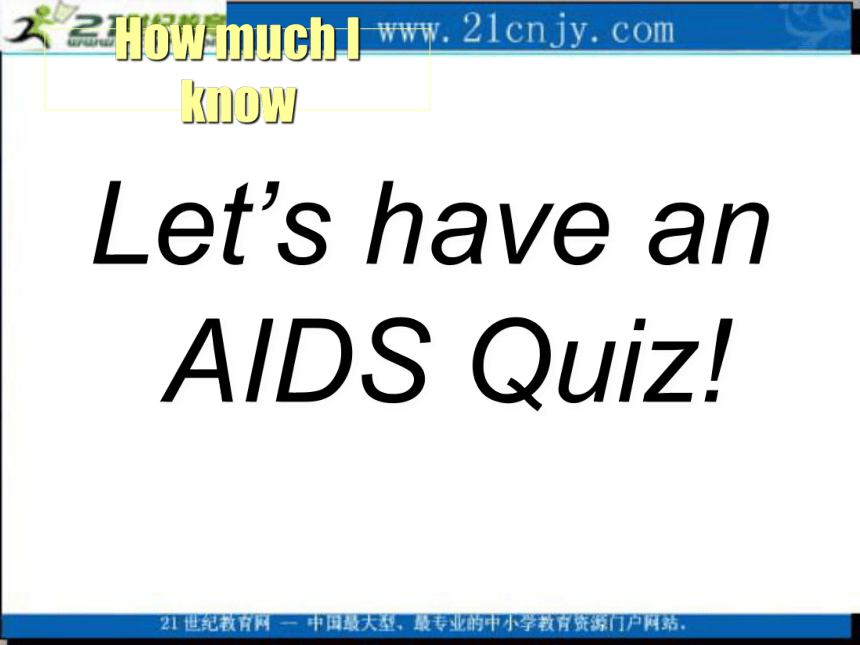
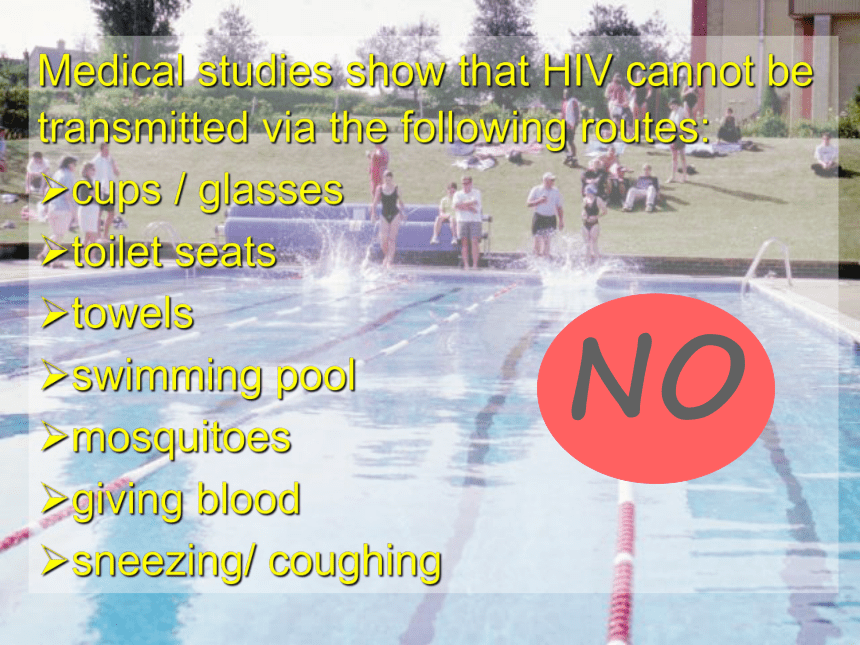
文档简介
课件21张PPT。Welcome to the UnitUnit 3 Protecting ourselvesHow much do we know about diseases?deadly diseasesinfectious diseasesincurablecurableAIDS virusThe red ribbon is an international symbol of AIDS awareness that is worn by people all year round and particularly around World AIDS Day to demonstrate care and concern about HIV and AIDS, and to remind others of the need for their support and commitment.
The red ribbon started as a "grass roots" effort; as a result there is no one official AIDS ribbon manufacturer, and many people make their own. It's easily done - just use some ordinary red ribbon and a safety pin! Red ribbon
AIDS
awareness
Care and concern
fight against AIDS
According to UNAIDS estimates, there are now 33.2 million people living with HIV, including 2.5 million children. During 2007 some 2.5 million people became newly infected with the virus. Around half of all people who become infected with HIV do so before they are 25 and are killed by AIDS before they are 35.
Around 95% of people with HIV/AIDS live in developing nations. But HIV today is a threat to men, women and children on all continents around the world.
Started on 1st December 1988, World AIDS Day is not just about raising money, but also about increasing awareness, fighting prejudice and improving education. World AIDS Day is important in reminding people that HIV has not gone away, and that there are many things still to be done. What’s the theme for the WAD2007 - Stop AIDS; Keep the Promise -
Leadership
2006 - Stop AIDS; Keep the Promise –
Accountability
2005 - Stop AIDS; Keep the Promise 2004 - Women, Girls, HIV and AIDS
2003 - Stigma & Discrimination
2002 - Stigma & Discrimination
2001 - I care. Do you?
2000 - AIDS : Men make a difference 1999 - Listen, Learn, Live: World AIDS Campaign
with Children & Young People
1998 - Force for Change: World AIDS Campaign
With Young People
1997 - Children Living in a World with AIDS
1996 - One World, One Hope
1995 - Shared Rights, Shared Responsibilities
1994 - AIDS & the Family
1993 - Act
1992 - Community Commitment
1991 - Sharing the Challenge
1990 - Women & AIDS
1989 - Youth
1988 - Communication How much I knowLet’s have an AIDS Quiz!Can the AIDS virus be transmitted via the following routes?NONONONONONONOMedical studies show that HIV cannot be transmitted via the following routes:
cups / glasses
toilet seats
towels
swimming pool
mosquitoes
giving blood
sneezing/ coughing Now let’s study the pictures!Picture 1
This poster is about Aids. It shows a poster of people holding a big picture that is covered in handprints. The handprints are different colors, and this shows that Aids can affect everyone, no matter what their skin color is or what country they are from. This tells us that Aids is an international problem that we have to work together to try and fight. Aids: acquired immunodeficiency syndrome (获得性免疫缺陷综合症)
HIV: human immunodeficiency virus (人类免疫缺陷病毒)
World Aids Day: 1 December
Aids patients/victim: people who have Aids and are suffering from it
HIV carriers: people who are carrying the virus called HIV Picture 2
Everyone knows smoking causes great harm to one’s health, but many smokers just keep on smoking. This poster wants to persuade them to give up cigarettes. The human skull with a cigarette between its lips shows that the result of smoking is death.1990 "Childhood and Youth without Tobacco: Growing up without Tobacco "
1991 "Public Places and Transport: Better Be Tobacco-Free"
1992 "Tobacco-Free Workplaces: Safer and Healthier"
1993 "Health Services: our window to a tobacco free world" 1994 "The media and tobacco: getting the message across”
1995 "Tobacco costs more
1996 "Sport and art without tobacco: play it tobacco free"
1997 "United for a tobacco free world"
1998 "Growing up without tobacco" 1999 "Leave the pack behind" 2000 "Tobacco kills don’t be duped"
2001 "Second hand smoke kills"
2002 "Tobacco free sports"
2003?"Tobacco free fashion tobacco free films"
Picture 3
The warning ‘Say No to drugs!’ tells us that we must not take drugs. Drug-taking is a global problem, so the whole world is paying special attention to this problem. 26 June is International Day against Drug Abuse and Illicit Trafficking. Picture 4
This poster shows a damaged car that has obviously been in an accident. From the words ‘Don’t drink and drive!’ we can know what caused the accident. The driver was probably drinking alcohol before driving. In many countries, driving after drinking is the main cause of traffic accidents every year. Discussion
1. Why do you think people do things that are wrong and dangerous to their health and lives?
2. What do you know about Aids?
3. Can you think of some other bad habits that harm people’s health and lives?Homework
1. Collect more information about Aids after class.
2. Prepare the Reading part.Thank you!
The red ribbon started as a "grass roots" effort; as a result there is no one official AIDS ribbon manufacturer, and many people make their own. It's easily done - just use some ordinary red ribbon and a safety pin! Red ribbon
AIDS
awareness
Care and concern
fight against AIDS
According to UNAIDS estimates, there are now 33.2 million people living with HIV, including 2.5 million children. During 2007 some 2.5 million people became newly infected with the virus. Around half of all people who become infected with HIV do so before they are 25 and are killed by AIDS before they are 35.
Around 95% of people with HIV/AIDS live in developing nations. But HIV today is a threat to men, women and children on all continents around the world.
Started on 1st December 1988, World AIDS Day is not just about raising money, but also about increasing awareness, fighting prejudice and improving education. World AIDS Day is important in reminding people that HIV has not gone away, and that there are many things still to be done. What’s the theme for the WAD2007 - Stop AIDS; Keep the Promise -
Leadership
2006 - Stop AIDS; Keep the Promise –
Accountability
2005 - Stop AIDS; Keep the Promise 2004 - Women, Girls, HIV and AIDS
2003 - Stigma & Discrimination
2002 - Stigma & Discrimination
2001 - I care. Do you?
2000 - AIDS : Men make a difference 1999 - Listen, Learn, Live: World AIDS Campaign
with Children & Young People
1998 - Force for Change: World AIDS Campaign
With Young People
1997 - Children Living in a World with AIDS
1996 - One World, One Hope
1995 - Shared Rights, Shared Responsibilities
1994 - AIDS & the Family
1993 - Act
1992 - Community Commitment
1991 - Sharing the Challenge
1990 - Women & AIDS
1989 - Youth
1988 - Communication How much I knowLet’s have an AIDS Quiz!Can the AIDS virus be transmitted via the following routes?NONONONONONONOMedical studies show that HIV cannot be transmitted via the following routes:
cups / glasses
toilet seats
towels
swimming pool
mosquitoes
giving blood
sneezing/ coughing Now let’s study the pictures!Picture 1
This poster is about Aids. It shows a poster of people holding a big picture that is covered in handprints. The handprints are different colors, and this shows that Aids can affect everyone, no matter what their skin color is or what country they are from. This tells us that Aids is an international problem that we have to work together to try and fight. Aids: acquired immunodeficiency syndrome (获得性免疫缺陷综合症)
HIV: human immunodeficiency virus (人类免疫缺陷病毒)
World Aids Day: 1 December
Aids patients/victim: people who have Aids and are suffering from it
HIV carriers: people who are carrying the virus called HIV Picture 2
Everyone knows smoking causes great harm to one’s health, but many smokers just keep on smoking. This poster wants to persuade them to give up cigarettes. The human skull with a cigarette between its lips shows that the result of smoking is death.1990 "Childhood and Youth without Tobacco: Growing up without Tobacco "
1991 "Public Places and Transport: Better Be Tobacco-Free"
1992 "Tobacco-Free Workplaces: Safer and Healthier"
1993 "Health Services: our window to a tobacco free world" 1994 "The media and tobacco: getting the message across”
1995 "Tobacco costs more
1996 "Sport and art without tobacco: play it tobacco free"
1997 "United for a tobacco free world"
1998 "Growing up without tobacco" 1999 "Leave the pack behind" 2000 "Tobacco kills don’t be duped"
2001 "Second hand smoke kills"
2002 "Tobacco free sports"
2003?"Tobacco free fashion tobacco free films"
Picture 3
The warning ‘Say No to drugs!’ tells us that we must not take drugs. Drug-taking is a global problem, so the whole world is paying special attention to this problem. 26 June is International Day against Drug Abuse and Illicit Trafficking. Picture 4
This poster shows a damaged car that has obviously been in an accident. From the words ‘Don’t drink and drive!’ we can know what caused the accident. The driver was probably drinking alcohol before driving. In many countries, driving after drinking is the main cause of traffic accidents every year. Discussion
1. Why do you think people do things that are wrong and dangerous to their health and lives?
2. What do you know about Aids?
3. Can you think of some other bad habits that harm people’s health and lives?Homework
1. Collect more information about Aids after class.
2. Prepare the Reading part.Thank you!
同课章节目录
- 模块9
- Unit 1 Other countries, other cultures
- Unit 2 Witnessing time
- Unit 3 The meaning of colou
- Unit 4 Behind beliefs
- 模块10
- unit 1 building the future
- unit 2 people on the move
- unit 3 protecting ourselves
- unit 4 law and orde
- 模块11
- unit 1 careers and skills
- unit 2 getting a job
- unit 3 the secret of success
- unit 4 the next step
